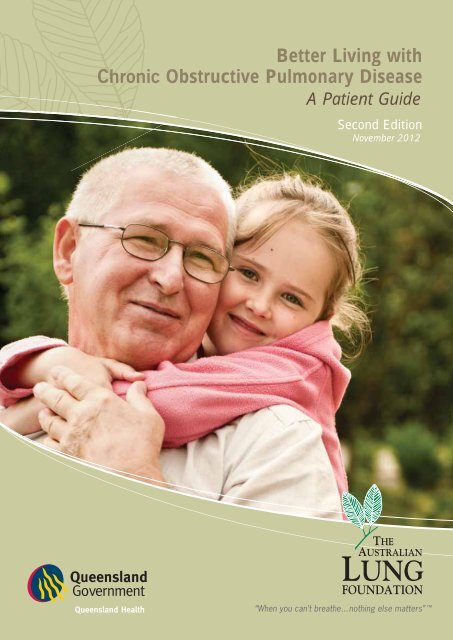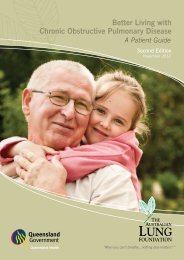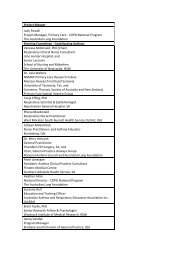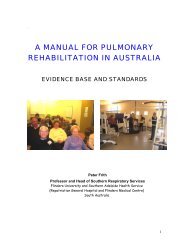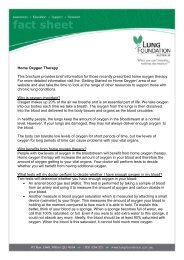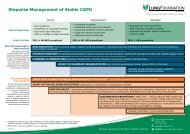Introduction - Lung Foundation
Introduction - Lung Foundation
Introduction - Lung Foundation
You also want an ePaper? Increase the reach of your titles
YUMPU automatically turns print PDFs into web optimized ePapers that Google loves.
Better Living with Chronic Obstructive Pulmonary Disease A Patient Guide<br />
Better Living with<br />
Obstructive Pulmonary Disease<br />
A Patient Guide<br />
Second Edition<br />
November 2012<br />
Queensland Health<br />
©The State of Queensland (Queensland Health) and The Australian <strong>Lung</strong> <strong>Foundation</strong> 2012<br />
a
Better Living with Chronic Obstructive Pulmonary Disease A Patient Guide<br />
Better Living with Chronic Obstructive Pulmonary Disease A Patient Guide is a joint project of the<br />
Statewide COPD Respiratory Network, Clinical Practice Improvement Centre, Queensland Health and<br />
The Australian <strong>Lung</strong> <strong>Foundation</strong>, COPD National Program.<br />
This work is copyright and copyright ownership is shared between the State of Queensland (Queensland Health)<br />
and The Australian <strong>Lung</strong> <strong>Foundation</strong> 2012. It may be reproduced in whole or in part for study, education or<br />
clinical purposes subject to the inclusion of an acknowledgement of the source. It may not be reproduced<br />
for commercial use or sale. Reproduction for purposes other than those indicated above requires written<br />
permission from both Queensland Health and The Australian <strong>Lung</strong> <strong>Foundation</strong>.<br />
© The State of Queensland (Queensland Health) and The Australian <strong>Lung</strong> <strong>Foundation</strong> 2012.<br />
For further information contact Statewide Respiratory Clinical Network, Patient Safety and Quality Improvement<br />
Service, e-mail: PSQ@health.qld.gov.au or phone: (07) 36369505 and The Australian <strong>Lung</strong> <strong>Foundation</strong>,<br />
e-mail: enquiries@lungfoundation.com.au or phone: 1800 654 301. For permissions beyond the scope of<br />
this licence contact: Intellectual Property Offi cer, Queensland Health, email: ip_offi cer@health.qld.gov.au<br />
or phone (07) 3234 1479.<br />
To order resources or to provide feedback please email: enquiries@lungfoundation.com.au or<br />
phone 1800 654 301.<br />
Queensland Health Statewide Respiratory Clinical Network and The Australian <strong>Lung</strong> <strong>Foundation</strong>, COPD<br />
National Program – Better Living with Chronic Obstructive Pulmonary Disease A Patient Guide, 2012.<br />
ISBN 978-0-9872272-0-1<br />
b<br />
Chapter 5: Your role in managing your chronic obstructive pulmonary disease
chapter<br />
1<br />
Better Living with Chronic Obstructive Pulmonary Disease A Patient Guide<br />
<strong>Introduction</strong><br />
Chronic Obstructive Pulmonary Disease (COPD) is an umbrella term for a group of disorders that cause<br />
obstruction of airfl ow in the breathing tubes or airways of the lungs. When the condition occurs it is<br />
chronic (long term) in nature, and therefore the airfl ow obstruction is usually permanent or ‘irreversible’.<br />
C – chronic – long term<br />
O – obstructive – partly blocked<br />
P – pulmonary – the lungs<br />
D – disease – or illness<br />
These conditions commonly include chronic bronchitis,<br />
emphysema and chronic asthma. The Australian <strong>Lung</strong><br />
<strong>Foundation</strong> estimates that one in seven Australians<br />
over 40 years of age has COPD. Alarmingly at least<br />
50% of those people do not know they have COPD,<br />
and, therefore are not taking the important steps to<br />
control their symptoms and slow down the progress<br />
of this disabling condition.<br />
Breathlessness, a key symptom of COPD, creeps up<br />
on people slowly. As symptoms begin people may<br />
not be able to run to catch the train or play with<br />
young children. However, breathlessness can worsen<br />
to a stage where everyday tasks, such as hanging<br />
out the washing or walking to get the mail, become<br />
more and more diffi cult.<br />
If you have COPD, the good news is that there are<br />
steps you can take to control the symptoms of COPD<br />
and slow down the ongoing damage to your lungs.<br />
Better Living with Chronic Obstructive Pulmonary<br />
Disease A Patient Guide outlines the important<br />
steps that will make you feel better, such as:<br />
Quitting smoking.<br />
Understanding your medications.<br />
Enrolling in a pulmonary rehabilitation program.<br />
Maintaining a healthy diet.<br />
Developing an Action Plan.<br />
Joining a support group.<br />
Discussing immunisation with your doctor.<br />
Better Living with Chronic Obstructive Pulmonary<br />
Disease A Patient Guide has been written specifically<br />
for people with COPD. However, there are many<br />
chronic lung conditions for which the principles and<br />
advice written in these pages will apply.<br />
For more information about this Patient Guide<br />
and how to use it, contact The Australian <strong>Lung</strong><br />
<strong>Foundation</strong> (phone: 1800 654 301 or website:<br />
www.lungfoundation.com.au) or speak to your<br />
doctor, nurse or pulmonary rehabilitation coordinator.<br />
1 Chapter 1: <strong>Introduction</strong>


